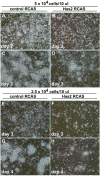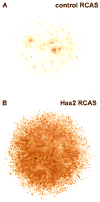Hyaluronan in limb morphogenesis
- PMID: 17362908
- PMCID: PMC2077829
- DOI: 10.1016/j.ydbio.2007.02.023
Hyaluronan in limb morphogenesis
Abstract
Hyaluronan (HA) is a large glycosaminoglycan that is not only a structural component of extracellular matrices, but also interacts with cell surface receptors to promote cell proliferation, migration, and intracellular signaling. HA is a major component of the extracellular matrix of the distal subapical mesenchymal cells of the developing limb bud that are undergoing proliferation, directed migration, and patterning in response to the apical ectodermal ridge (AER), and has the functional potential to be involved in these processes. Here we show that the HA synthase Has2 is abundantly expressed by the distal subridge mesodermal cells of the chick limb bud and also by the AER itself. Has2 expression and HA production are downregulated in the proximal central core of the limb bud during the formation of the precartilage condensations of the skeletal elements, suggesting that downregulation of HA may be necessary for the close juxtaposition of cells and the resulting cell-cell interactions that trigger cartilage differentiation during condensation. Overexpression of Has2 in the mesoderm of the chick limb bud in vivo results in the formation of shortened and severely malformed limbs that lack one or more skeletal elements. Skeletal elements that do form in limbs overexpressing Has2 are reduced in length, exhibit abnormal morphology, and are positioned inappropriately. We also demonstrate that sustained HA production in micromass cultures of limb mesenchymal cells inhibits formation of precartilage condensations and subsequent chondrogenesis, indicating that downregulation of HA is indeed necessary for formation of the precartilage condensations that trigger cartilage differentiation. Taken together these results suggest involvement of HA in various aspects of limb morphogenesis.
Figures







Similar articles
-
Temporal and spatial analysis of hyaluronidase activity during development of the embryonic chick limb bud.Dev Biol. 1987 Apr;120(2):535-41. doi: 10.1016/0012-1606(87)90256-9. Dev Biol. 1987. PMID: 3556767
-
Hyaluronan-mediated aggregation of limb bud mesenchyme and mesenchymal condensation during chondrogenesis.Exp Cell Res. 1996 May 25;225(1):55-66. doi: 10.1006/excr.1996.0156. Exp Cell Res. 1996. PMID: 8635517
-
Involvement of Frzb-1 in mesenchymal condensation and cartilage differentiation in the chick limb bud.Int J Dev Biol. 1999 Sep;43(6):495-500. Int J Dev Biol. 1999. PMID: 10610022
-
Ectoderm as a determinant of early tissue pattern in the limb bud.Cell Differ. 1984 Nov;15(1):17-24. doi: 10.1016/0045-6039(84)90025-3. Cell Differ. 1984. PMID: 6394145 Review.
-
The tissues and regulatory pattern of limb chondrogenesis.Dev Biol. 2020 Jul 15;463(2):124-134. doi: 10.1016/j.ydbio.2020.04.009. Epub 2020 May 15. Dev Biol. 2020. PMID: 32417169 Review.
Cited by
-
Hapln1a is required for connexin43-dependent growth and patterning in the regenerating fin skeleton.PLoS One. 2014 Feb 12;9(2):e88574. doi: 10.1371/journal.pone.0088574. eCollection 2014. PLoS One. 2014. PMID: 24533114 Free PMC article.
-
Bone quality relies on hyaluronan synthesis - Insights from mice with complete knockout of hyaluronan synthase expression.Matrix Biol Plus. 2024 Oct 9;24:100163. doi: 10.1016/j.mbplus.2024.100163. eCollection 2024 Dec. Matrix Biol Plus. 2024. PMID: 39736893 Free PMC article.
-
Vertebrate skeletogenesis.Curr Top Dev Biol. 2010;90:291-317. doi: 10.1016/S0070-2153(10)90008-2. Curr Top Dev Biol. 2010. PMID: 20691853 Free PMC article. Review.
-
Hyaluronan as a therapeutic target in human diseases.Adv Drug Deliv Rev. 2016 Feb 1;97:186-203. doi: 10.1016/j.addr.2015.10.017. Epub 2015 Nov 2. Adv Drug Deliv Rev. 2016. PMID: 26541745 Free PMC article. Review.
-
Extracellular Matrix and Cellular Plasticity in Musculoskeletal Development.Front Cell Dev Biol. 2020 Aug 25;8:781. doi: 10.3389/fcell.2020.00781. eCollection 2020. Front Cell Dev Biol. 2020. PMID: 32984311 Free PMC article. Review.
References
-
- Asira A, Miyauchi S, Miyazaki K, Hamai A, Horie K, Takahashi T, Sekiguchi T, Machida A, Kohno K, Uchiyama Y. Intra- and extracellular localization of hyaluronic acid and proteoglycan constituents (chondroitin sulfate, keratin sulfate, and protein core) in articular cartilage of rabbit tibia. J Histochem Cytochem. 1992;40:1693–1703. - PubMed
-
- Bakkers J, Kramer C, Pothof J, Quaedvlieg NEM, Spaink HP, Hammerschmidt M. Has2 is required upstream of Rac1 to govern dorsal migration of lateral cells during zebrafish gastrulation. Development. 2004;131:525–537. - PubMed
-
- Becker TC, Noel RJ, Coats WS, Gomez-Foix AM, Alam T, Gerard RD, Newgard CB. Use of recombinant adenovirus for metabolic engineering of mammalian cells. Methods Cell Biol. 1994;43:161–189. - PubMed
-
- Bourguignon LYW, Singleton PA, Zhu H, Zhou B. Hyaluronan promotes signaling interactions between CD44 and the transforming growth factor β receptor I in metastatic breast tumor cells. J Biol Chem. 2002;277:39703–39712. - PubMed
-
- Bourguignon LYW, Zhu H, Chu A, Iida N, Zhang L, Hung MC. Interaction between the adhesion receptor, CD44, and the oncogene product p185HER2, promotes human ovarian tumor cell activation. J Biol Chem. 1997;272:27913–27918. - PubMed
Publication types
MeSH terms
Substances
Grants and funding
LinkOut - more resources
Full Text Sources
Other Literature Sources

